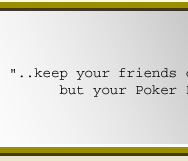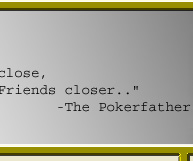There are three kinds of Texas Hold'em Poker Games: Fixed Limit
Hold'em, Pot Limit Hold'em, and the ever popular No Limit Hold'em
(also see Texas Hold'em Tournament
Tips)
Side Note: Texas Hold'em Poker
is also known as Hold'em Poker, Texas Poker, No Limit Poker, No
Limit Hold'em and has been spelled differently by numerous people.
The Correct Spelling is "Texas Hold'em Poker"; not Holdem,
Hold em, Holdum, or any other version you may have seen (see Texas
Hold'em Poker History)
Limit Texas Hold'em Poker
In Limit Texas Hold'em Poker Games, bets and raises are set at
a fixed amount. A typical limit game would be $10/$20 ($10 minimum
bet for the first two rounds, and $20 minimum for the last two
rounds). The big blind would be equal to the minimum bet ($10)
and the small blind would be half the minimum bet ($5). Each round
of betting is capped at a maximum number of raises, depending
on the rules of the game. In online Hold'em games, raises are
generally capped at four bets per round. New players will start
with low-limit games and gradually work their way up to higher
limits as their skill progresses.
Pot Limit Texas Hold'em Poker
Pot Limit Texas Hold'em Poker is similar to No Limit
Hold'em, except that the number of chips currently in the pot
determines the maximum bet. This allows players to experience
the excitement and strategy of No Limit Texas Hold'em without
the necessity of a large bankroll. Pot Limit games usually have
a maximum buy-in (the number of chips you start with) to keep
the game competitive.
No Limit Texas Hold'em Poker
In No Limit Texas Hold'em Poker, the number of chips you have
in front of you determines the maximum bet. Players can bet and
raise by any amount, and at any time, a player can go all-in by
pushing all their chips toward the center of the table. To call,
the other players at the table must push in all of their chips,
up to the amount of their opponent's all-in bet. This is the type
of Hold'em that is played on the pro level, and on TV shows such
as the World Poker Tour and the World Series of Poker.
The Game - Texas Hold'em Poker
The texas poker game begins with each player being dealt two pocket
cards face down with five community cards dealt face up. The player
who makes the best five-card poker hand with any combination of
their two face down cards and the five community cards wins the
round. (see Texas Hold'em Poker
Starting Hands)
A disc or other marker is used to indicate which person is the
dealer for the round. Action is always initiated to the left of
the dealer and continues in a clockwise manner. At the end of
each hand the button is moved clockwise to the next player, who
then becomes the dealer.
There are no antes in Texas Hold’em Poker, instead forced
bets called blinds are used. Before the cards are dealt, the person
to the left of the dealer posts a bet called the small blind,
which is usually equal to half of the minimum bet. The person
to the left of the small blind posts the big blind, which is equal
to the minimum bet.
The first two cards are dealt to each player face down (these
are called the hole card), and the person to the left of the big
blind starts the first round of betting. (Notice that the big
blind and small blind do not get to look at their cards before
betting, thus the term blind).
The First Round of Betting in Texas Hold'em Poker
In the first round of betting, each player has three options:
call, raise or fold. To call, the player must place a bet that
is equal to the last bet placed. (For the first player in the
round, this would be equal to the minimum bet.) A player may choose
to raise their call bet by an additional amount, which the other
players will then have to call. If one's hole card are not favorable,
the player may simply choose to fold and sit out the round.
The Flop
After all the players have finished the first round of betting,
the first three community cards are dealt face-up on the board.
This is called the flop. The second and all subsequent betting
rounds start with the first player to the dealer's left, and players
now have the option to check. By checking, the player indicates
interest in the pot without placing a bet. Any player may choose
to place a bet, which the other players must then call. Players
can still raise, if a bet has been made, or fold, if their hand
is not favorable. After the second betting round, the fourth community
card is dealt face-up (this is called the turn card).
(see Texas Hold'em Poker Pre-Flop Odds)
In limit games, the minimum bet doubles in the last two rounds
of betting. After the third betting round, the fifth and final
community card is dealt (this is called the river card). A final
round of betting ensues, and afterwards each player turns his
or her hole card face up. The highest hand that can be made with
any combination of a player's hole card and the five community
cards wins the pot.
If two or more players have the same hand, the next highest card
in the player's hand (the kicker) is used to break a tie. If there
is no kicker card (the tied players have used both hole cards,
or have the exact same hand), then the pot is split between them.
The dealer button is then passed clockwise to the next player
and another round of play begins.
General Sequence of Texas Hold'em Poker Play:
1. The dealer deals each player 2 down cards.
2. 1st round of betting.
3. The dealer burns a card and deals the flop.
4. 2nd round of betting.
5. Another card is burned and a fourth community card the turn
is dealt.
6. 3rd round of betting.
7. A last card is burned and the final community card or river
is dealt.
8. The last round of betting.
9. All remaining players participate in a showdown. Each player
makes his or her best 5-card poker hand. The
10. The person who initiated the last round of betting shows his/her
cards first.
Texas Hold’em 5 card hands may contain any combination of
the following:
A. Both of the player’s hole card along with any three cards
from the community board.
B. One of the player’s hole card along with any four cards
from the community board.
C. None of the player’s hole card and all five cards from
the community board
(top)
Skip To:
General Poker - Texas
Hold'em Poker - Omaha Poker - 5
Card Stud
7 Card Stud - Hand
Rankings - Poker Odds
Please Also See:
Poker
Tips - Poker
Lessons - Tournament
Tips - Poker
Rules
Poker
Starting Hands - Estimating
Odds - Poker
Strategy
|





